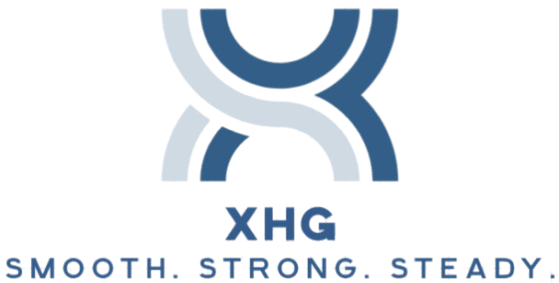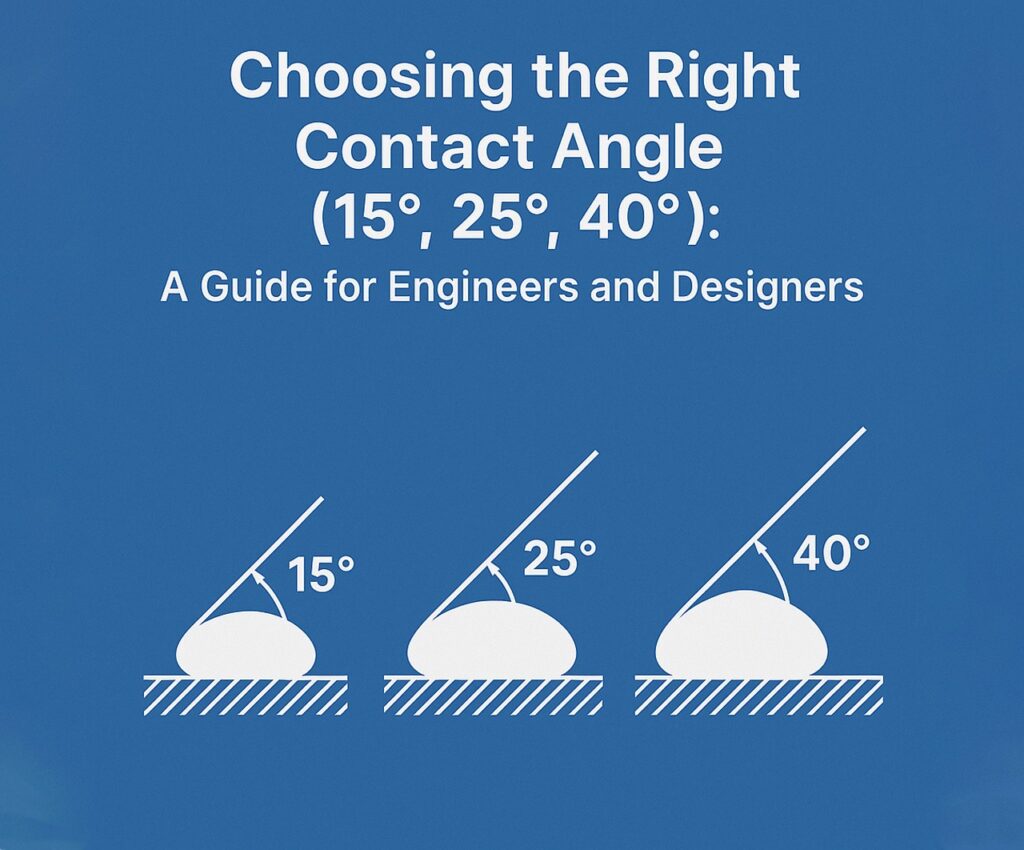When you’re designing a system with precise rotational performance, every component matters—and bearings are at the core of that conversation. If you’re comparing specs, reviewing an angular contact ball bearing number, weighing the angular contact ball bearing price, or deciding on an angular contact ball bearing single row configuration, understanding the right contact angle is essential. The contact angle determines how the bearing handles axial and radial loads, influences stiffness, and plays a role in speed limits and lifespan. Know More
Ask ChatGPT
What is Contact Angle?
The contact angle of a bearing is the angle formed between the line of action of the load transmitted through the ball and the radial plane of the bearing. In simpler terms, it defines how the bearing manages axial loads. The three most common contact angles are 15°, 25°, and 40°.
Each angle offers specific advantages depending on the application. Choosing the right one involves more than just checking the angular contact ball bearing number; it’s about understanding performance trade-offs.
Quick Overview of Angular Contact Ball Bearings
An angular contact ball bearing single row is built to handle both radial and axial loads, but in one direction. These are commonly mounted in pairs or sets to accommodate bidirectional loads. The orientation, preload, and most importantly, the contact angle all impact the bearing’s behavior.
You may notice that the angular contact ball bearing price varies not just by size or brand but also by the chosen contact angle and configuration. The reason? Performance capabilities change significantly based on angle.
15° Contact Angle: Speed and Precision
Key Benefits:
- High-speed capability
- Low friction
- Ideal for high-precision applications
A 15° contact angle is suited for applications where axial loads are low, but precision and speed are high priorities. Think high-speed spindles, dental drills, and certain aerospace mechanisms. This low angle keeps the rolling elements closer to a pure radial path, minimizing friction and enabling high RPMs.
If you’re sourcing a high-speed angular contact ball bearing single row, the angular contact ball bearing price for a 15° version may be slightly higher due to specialized materials or precision requirements.
Best For:
- CNC spindles
- High-speed turbines
- Jet engines
Limitations:
- Limited axial load capacity
- Less robust under combined loads
25° Contact Angle: Balanced Performance
Key Benefits:
- Good balance between speed and axial load capacity
- Versatile for many general industrial applications
A 25° angle is often the default choice for many angular contact ball bearing single row units. It provides a strong middle ground—enough axial load handling for most setups, without sacrificing speed and efficiency.
When comparing the angular contact ball bearing number, a 25° bearing often doesn’t require special notation; it’s the assumed standard unless otherwise specified.
Best For:
- Pumps and compressors
- Gearboxes
- Medium-speed machinery
Limitations:
- Not specialized for either extreme speed or heavy axial load
40° Contact Angle: Load Powerhouse
Key Benefits:
- Superior axial load capacity
- Robust under combined loads
- Improved rigidity and stability
A 40° contact angle means the load path goes more diagonally across the raceways. That gives it a stronger axial component, making it ideal for setups where axial forces are significant, like thrust-heavy assemblies or inclined gear trains.
Due to their durability, angular contact ball bearing price tends to be slightly higher in the 40° category, especially in high-durability or sealed models.
Best For:
- Screw drives
- Vertical shaft applications
- Industrial presses
Limitations:
- Higher friction at speed
- Reduced maximum RPM
Interpreting the Angular Contact Ball Bearing Number
Every angular contact ball bearing number tells a story. Embedded in the number are indicators of:
- Bore size
- Width series
- Outer diameter
- Contact angle (often via suffixes like “C” for 15°, “AC” for 25°, and “B” or “A” for 40°)
When selecting bearings based on the number alone, be cautious. Always verify the suffix that indicates the contact angle. A minor oversight can lead to performance mismatches or even mechanical failure.
Pairing Bearings: Matching Angles for Function
Angular contact ball bearing single row types are often mounted in pairs for dual-directional axial load capacity. When doing this, ensure all bearings have the same contact angle, or you’ll introduce misalignment and uneven load distribution.
Configurations like:
- Back-to-back (DB): Better for moment loads
- Face-to-face (DF): More tolerant of misalignment
- Tandem (DT): Doubles axial load capacity in one direction
Each of these setups performs differently with different contact angles. For example, a 40° tandem pair excels at heavy thrust but runs hotter at high speeds.
Comparing Prices: Why Contact Angle Affects Cost
The angular contact ball bearing price fluctuates based on contact angle due to:
- Machining complexity
- Material requirements
- Precision class
- Speed vs. load balancing
Higher angles (like 40°) often demand more robust cages, better heat treatment, and specific lubricants. Lower angles (like 15°), especially for high-speed uses, require tight tolerances and advanced materials like hybrid ceramics.
If you’re optimizing cost, match the bearing angle precisely to your load and speed requirements. Over-specifying leads to unnecessary expense.
Application-Based Recommendations
Robotics and Automation
- Recommended Angle: 15° or 25°
- Why: High speed and moderate load, precision positioning
Aerospace and Defense
- Recommended Angle: 15°
- Why: High-speed, low-load, weight-sensitive design
Automotive Gearboxes
- Recommended Angle: 25° or 40°
- Why: Medium to heavy axial load under rotational torque
Industrial Screw Drives
- Recommended Angle: 40°
- Why: High thrust loading and rigid performance needs
Lifespan and Failure Modes by Angle
15° Bearings
- Common Failure: Surface fatigue under heavy axial loads
- Lifespan: Long if speed is high and axial load is low
25° Bearings
- Common Failure: Contamination and lubrication degradation
- Lifespan: Medium to long, dependent on balance
40° Bearings
- Common Failure: Thermal stress due to friction
- Lifespan: Long under heavy load, reduced at high speeds
Choosing the wrong contact angle can significantly reduce service life and increase maintenance costs. The wrong bearing in the right system is still the wrong choice.
Hybrid Bearings and Custom Solutions
Many industries are now turning to hybrid bearings to optimize both speed and load performance. These may use ceramic balls with steel raceways and come in various contact angles. While the angular contact ball bearing price may be higher, so is the performance ceiling.
Also, custom contact angles (like 18° or 30°) are available for unique scenarios. Talk to manufacturers if you’re building a bespoke system where the standard angles don’t apply.
Final Checklist for Contact Angle Selection
- Determine Load Ratio: What’s the proportion of axial to radial load?
- Speed Requirements: What RPM range does the shaft reach?
- Temperature and Friction: How much heat is acceptable in the system?
- Mounting Method: Will the bearings be used in matched pairs?
- Budget: What’s the target angular contact ball bearing price?
By walking through this checklist, you ensure the angular contact ball bearing single row you select meets not just today’s specs, but tomorrow’s performance goals.
Conclusion: The Right Angle for the Right Job
In bearing selection, contact angle isn’t just a number—it’s a strategic decision that defines performance, cost, and reliability. Whether you’re matching an angular contact ball bearing number for replacement, benchmarking angular contact ball bearing price for procurement, or fine-tuning an angular contact ball bearing single row setup for a new design, angle matters.
Choose 15° for precision and speed. Opt for 25° for balance and versatility. Go with 40° when axial loads dominate. Make the right choice, and your machinery will thank you with years of smooth, efficient service.

